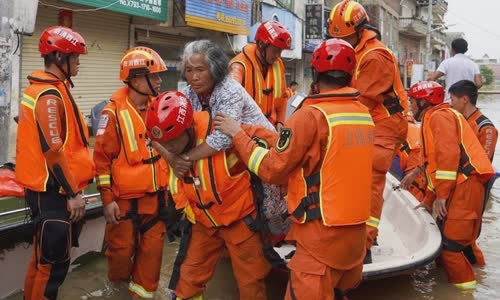Huang Huoxiu stood in a three-story house, watching the rushing floodwaters flow toward her, after the dike near the house broke in the afternoon of July 8.
At the same time, she saw her neighbor take three young children out of the village of Kieu Dau in Thuong Nhieu, Jiangxi Province, southern China.

Ms. Huang Huoxiu (right) sat on a rescue boat in Qiaotou Village, Jiangxi Province, July 11 Photo: SCMP.
She took them to her house, where within half an hour, water had risen to the second floor.
The neighbor burst into tears.
Their Kieu Dau village is one of many places hit by severe floods this week, with 20,000 residents stranded in a state of blackouts and without clean water.
Heavy rains and floods have continued for weeks in central and southern China, affecting nearly 34 million people in 27 provinces, according to official statistics.
Huang's village is one of many areas near Ba Yang Lake, China's largest freshwater lake.
Officials warned the lake level could reach a record level of 22.59 m as in July 1998.
On the evening of July 10, the measured water level was approximately 22 meters, according to Chen Guiya, deputy director of the Changjiang Water Resources Committee.

Rescuers carry an old lady on her back after rescuing from flood waters in Jiangxi province, July 11 Photo: SCMP.
On the morning of July 11, floodwaters flooded roads in Kieu Dau.
Sitting on the Shangrao rescue boat, Sun Chao's deputy team leader said it was difficult to rescue people.
They also have to take a resident who knows the village's path, to avoid the risk of the boat hitting walls, wires or dangerous objects under the water.
When arriving at the people's home, firefighters will use ropes to fixed the boat to the fence before Sun climbs the balcony to rescue the people.
Huang Meifeng, a resident of Kieu Dau, was swept away by the floodwaters of a three-story house he just built last year.
She remembered the flood in 1998, when most of the houses in Kieu Dau were submerged for three months.



 Tami Johnston-Cook
Tami Johnston-Cook








